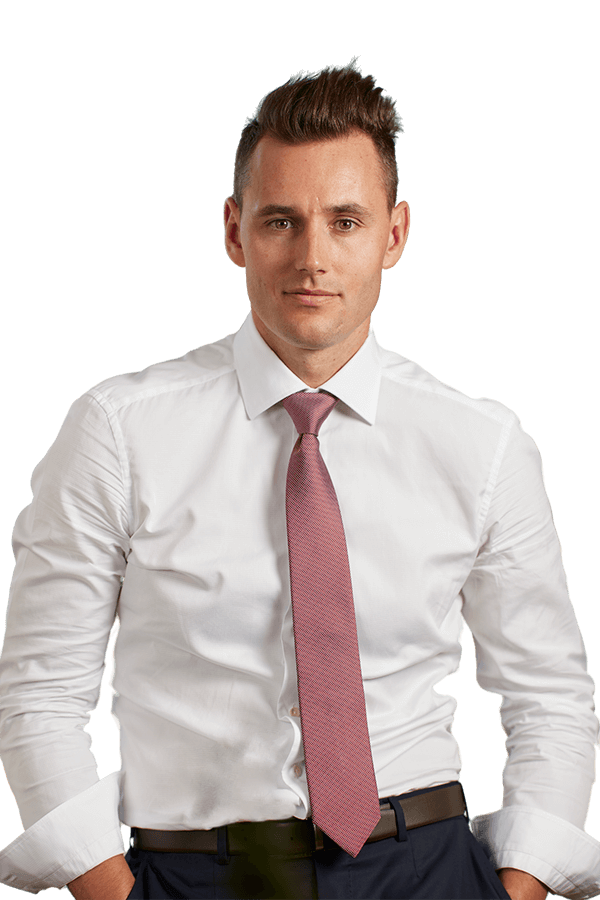Spinal fusion
to resolve specific types of nerve pain, bone pain or disc pain.
Spinal fusion key points
- Spinal fusion is spine surgery that involves removing a spinal disc and replacing it with a spacer that is locked in place with screws.
- After surgery your natural bone starts to grow in around the spacer. Once the bone from either side meets up, usually at the 12 month mark, the spinal fusion has taken place.
- Spinal fusion only works for specific types of nerve pain, bone pain and disc pain.
- The technology has changed hugely in the last few years and though every surgery carries risks, spinal fusion has become a safe and effective treatment for specific spine conditions.
Spinal fusion Brisbane
The spine surgeon said spinal fusion. What exactly is that?
Spinal fusion is a spinal surgery procedure that involves removing a spinal disc and replacing it with a spacer. Screws (and often two rods) are then inserted to hold it all in place.
The surgeon does not actually fuse the spine. The surgeon simply places the spacer and screws in the spine, like a scaffold, and then over the next 6-12 months your natural bone will grow over and through this scaffold. Once the bone from either side meets up and forms a solid connection, that is what we call a spinal fusion. There is usually over a 90% chance that spinal fusion surgery actually results in a spinal fusion at the 12 month mark.

Spinal surgeon Brisbane
There are only 3 types of spinal pain that spinal fusion works for.
- Nerve pain, caused by a spinal nerve being pinched inside the spine
- Bone pain, caused by two adjacent bones rubbing on each other
- Disc pain, caused by a damaged or irritated disc.
There is nothing magical about spinal fusion; it's all based on simple mechanics.
Spinal fusion for nerve pain:
A common way for nerve pain to occur is when the spinal disc wears out and gradually collapses down on top of the nerve. The best analogy is of a car up on a jack, with a mechanic under the car. If the jack starts to fail, the poor mechanic gets squashed and enters a world of pain, just like the nerve root when the spinal disc collapses on it. The obvious solution is to jack the car up again. Spinal fusion jacks the disc space up and frees up the nerve. The spacers are anywhere from 8-20mm tall.
Spinal fusion for bone pain:
Bone-sitting-on-bone doesn't cause pain. It's movement that causes pain (i.e bone rubbing on bone: like an arthritic hip is ok at rest, just painful when walking). Spinal fusion simply locks the two bones together, eliminating the movement and treating the cause of the pain. We also use artificial discs now (like artificial hips, and this is discussed here).
Spinal fusion to treat a damaged disc:
We know that damaged and irritated spinal discs can cause pain. The tricky part is working out which disc it is. Like bone pain, it's usually movement of the irritated disc that causes pain. Surgery removes the disc and locks that part of the spine together. No disc, no movement, hopefully, no pain. It is more complex than this but that is the fundamental idea. Again, artificial discs are sometimes used in this setting and are discussed here.
Different types of spinal fusion surgery
Where is the incision for spinal fusion?
To reach the spine, we either make an incision from your back, from the front or a host of other angles between your front and back.
- PLIF: The spine can be reached directly from your back (the incision is in the middle of your back). This operation is called a Posterior Lumbar Interbody Fusion.
- ALIF: The spine can be directly reached from the front (the incision is in your tummy). This is called Anterior Lumbar Interbody Fusion.
- TLIF, OLIF, DLIF and XLIF: Then between these two extremes are a host of other angles to reach the spine, between the front and the back. All these different angles to the spine were explored as surgeons looked for increasingly more efficient and less invasive ways to reach the spine.
Remember, the end result is the same fusion of the spine, differing only in how the spine is reached. There are pros and cons to all of these. I can take you through these and clarify which would be best for you.
Spinal fusion surgery Brisbane
Is it successful?
You have all heard the horror stories:
“I was never the same again after spine surgery”,
“Don’t let them touch your spine, you’ll end up in a wheelchair.”
There is no question spine surgery has risks. But now with modern technology spinal fusion has become a safe and effective treatment for specific spine conditions.
The key in modern times is the decision making process. It is up to the surgeon to make as good a decision as possible about who should and who should not have spinal fusion surgery. There are many factors to consider, including your symptoms, examination findings, your scan results, your lifestyle and future aspirations.

Spinal surgeon Brisbane
Also, keep in mind that fusion is a natural process. Your spine’s normal response to many different types of spine conditions is to fuse itself, including fractures, infection and arthritis. Surgery just tries to replicate this.
If you would like me to make this thorough assessment for you then contact my team to book an appointment.
Spinal fusion surgery risks
Is it safe?
Modern spinal fusion surgery is very advanced compared to 30, 20, even 10 years ago. The technology is exceptional, and all spine surgeons in Australia have access to the latest equipment, including computer-guided systems or robots. The engineering of all this technology is world-class.
Most people who have never been to an operation theatre won’t realise just how advanced a modern spinal fusion operation is. All of this technology and engineering has made the vast majority of surgery very safe.

Spinal surgeon Brisbane
Now, the single biggest factor determining safety and outcome is now surgeon experience and patient selection (the decision-making process).
There are 2 long term side effects I will talk to you about
- Adjacent level disease
- Failure of fusion
Adjacent level disease.
When a level in the spine is fused, it places slightly more stress on the level immediately above and below to compensate for that loss of movement. This added stress can theoretically lead to accelerated wear and tear. This in turn could cause you more symptoms and even lead to further surgery. Adjacent level disease is now a very well researched condition and there are many considerations put in place during surgery to avoid this complication.
Failure of fusion.
Surgeons don’t fuse the spine, we reconstruct the spine using spacers and screws which hold everything together in the short term. Over the long term, however, the spacer and screws act as a scaffold for new bone to grow over. When new bone growth from opposite sides of the scaffold link up, you have solid fusion. This is ideal. However, occasionally this does not happen. People who smoke, have poor health or don’t do a proper rehabilitation program after surgery are at the highest risk for fusion not occurring.
Very common. It is a weekly operation for most spine surgeons. The main difference from surgeon to surgeon is the direction they take to reach your spine.
That is the goal. The whole point of surgery is to improve your quality of life. And that usually means getting you back onto the golf course, or pain-free moving around the house or in the garden or playing sports. I will take all this into account when deciding how best to treat you.
The most common way to fuse the spine is to remove the spinal disc completely, insert a spacer to open up the spine back to its normal configuration, and then lock it all together with screws.
The screws are made out of titanium, so don’t worry, you will not set off the alarms at an airport.
Alternatives to spinal fusion surgery
Are there any other good options?
This depends on your spinal condition. I will look at this option when I see you for an appointment.
Spinal fusion recovery
What can and can't I do afterwards?
To get the best result you need to commit to a full recovery period. Recovery is like compound interest; if you do the time, you’ll get the best result. If you shortchange yourself and bail out early you will miss out on significant benefits long term.
But this does not mean you will be just resting during the recovery. I will actually encourage you to be as active as possible. It is very important to get your confidence back as soon as possible, and you will be surprised how much you are allowed to do straight after surgery.

Spinal surgeon Brisbane
I will take you through all this when I see you.
Once I’ve seen you I can give you a better idea regarding this. Typically it is between 1-4 days.
Most scars from spine surgery heal very well. I am as keen as you to have an incision that heals up beautifully.
I only use dissolvable sutures for the lumbar spine. For the cervical spine, there is a small cosmetic surgery to be removed at 7 days. I will remove it in my rooms.
Physiotherapy or pilates will be important to improve your confidence in movement and enhance your recovery. I am happy to speak directly with your own physio or pilates instructor.
Spinal surgeon Brisbane
What should I do now?
If you would like me to assess your spine condition, in light of the quality of life you are looking for, contact my team to book an appointment.
Ready to make an appointment?
Ramsay Specialist Centre
Suite 325
Newdegate St
Greenslopes QLD 4120
